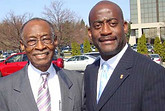top of page

in the first two weeks.
+400%
Reading between the lines...


Sometimes the story is not found in the statistics, but within the relationship between the statistics - often so subtle and yet, when you look back on it, the insight seems so obvious!
One such story is Heart Imaging...
ULTRAFAST CT SCANNING
Through their brand new clinic in the Southwest, Heart Imaging specialized in ultrafast CT (UFCT) scanning - a process of taking rapid cat-scan pictures of the heart while it beats. UFCT technology is about 95% accurate in detecting coronary artery disease. Better still, it allows patients to avoid the hassle and discomfort of the traditional cardiac stress test, with its injections, blood dyes, wires, treadmills, and nausea. But UFCT was not yet covered by managed care at the time. So, in order to drive interim revenue, Heart Imaging had launched a direct-to-consumer marketing campaign that targeted men in their 50s - offering paid scans (usually between $200 and $400) as part of a cardiac health screening.
The result? The target audience just wasn't buying it. With almost no response to Heart Imaging's advertising efforts, the company could scarcely fill their base appointments to keep the business afloat.
At the time, I was at the helm of Las Vegas ad agency Quillin & Co. We were called in to help.
To me, paid heart scans weren't an altogether crazy business idea. Baby Boomers were hitting their 50s in record numbers and executive physicals (often paid for out-of-pocket) were becoming popular. And the price? What was $250 for a heart scan? Heck, 50+ year-old affluent Boomers spent that much on dinners out each weekend.


4 million
men, age 50+, have a heart attack each year.
SELLING THE BOOGEYMAN
Heart Imaging's current advertising campaign relied only on that singular statistic, above - that 4 million men, age 50+, would have a heart attack this year. And you, the 50+ consumer, could be one of those 4 million! Then there were were the risk factors: Smoking. Drinking. Red meat. High cholesterol. High blood pressure.
And the #1 risk factor: Family history.
Your days could be numbered, the advertising contended, trying to frighten the target audience with their own hypothetical demise: Your heart could be a ticking time bomb!
The problem? This audience just didn't see middle age as a time of decline.
On the contrary...
-
They were peaking: The stock market, the economy, the housing market, and their bank accounts were all hitting record highs.
-
They were enjoying it: Luxury SUVs. McMansions. Exotic vacations. Cosmetic surgery among middle-aged men was growing, too. They were active and healthy, and fully engaged in life.
-
They refused to feel vulnerable: They saw themselves as captains of industry and lords of their own destiny - earning more and possessing more disposable income than they'd ever had in their lives. When they looked in the mirror, they could not see...they would not see...weakness or vulnerability.
I ultimately coined this 'The Adonis Complex' and assured the client that no "hypothetical, potential, mythical, ticking time bomb heart attack" message - based on their own vulnerability - would ever get through.
But that, too, was the conundrum. How do you get these guys to pay attention? How do you convince them of the seriousness of a hidden heart condition unless you scare the crap out of them?
We had hit a frustrating dead end.



Then one night...
...our brilliant ECD Glenn Larsen walked into my office carrying a printout of an EKG. "Ya know," he explained, holding up the strip of paper with its foreboding jagged lines, "This graphic is really scary, man!"
He was right! We talked at length about the EKG. We observed how - since the patient was usually unconscious - it was actually the family members who huddled around that machine, their greatest hopes and worst fears riding every peak and every valley of the readout.
In this situation, to those family members, every moment meant life or death.
And that's when the question dawned on me...

What if the #1 risk factor for a heart attack
- "Family history" - wasn't just about genetics,
but was also about a shared human experience?
DOING THE MATH...



I spent the next half-hour flipping through the Statistical Abstract from the US Census Bureau, uncovering the pertinent information. Embedded in the data was a story that went something like this:
4 million
men, age 50+, have a heart attack each year. Yes...we know that!
But if you increase the age to 70+, that number doubles. That is...
8 million
men, age 70+, have a heart attack each year.
According to the data: Each of these men aged 70+ had, an average of children each.
2
And what is the typical age of the adult children of 70-80 year-old heart attack victims?
50+
That's our target audience!
This meant that...
16 million
people in our target audience watched their fathers have a heart attack last year!!!
Are you kidding me??? That quadrupled the accessible audience for our client. And that number exponentially grew when you included heart attacks over the past several years...and then added in uncles, grandfathers, older co-workers, etc.
The sum total, as I explained to the client and agency team: We can talk about the consumer's hypothetical/mythical heart attack all day long and it's just not going to scare them. However, if we force them to recall the sheer terror of their father's very REAL heart attack?
That could absolutely traumatize them!
"IT'S YOUR FATHER..."
1:30am: The phone rings. It's your mother. Your father's had a heart attack.
2:12am: You jump in the car and you race across town.
3:05am: You arrive at the hospital.
4:46am: They wheel him into surgery. You wait. And wait. For hours.
8:17am: They bring him out of surgery and you're at his bedside. You've never seen him like this. Tubes. Wires. Machines. Labored breathing. The monitor beeps out its peaks and valleys. You think of your own children and family. Will they ever have to go through this with you?
And as you sit there in silence, watching his heart beat...
...who's watching yours?
Heart Imaging is!



RESUSCITATING THE BUSINESS...
The above story was the opening in what would become a landmark radio and print campaign for both the client and the agency - a creative collaboration between myself, ECD Glenn Larsen, and agency owner Tim Quillin (who also happens to be a really good radio producer).

The results were immediate:
-
Qualified call volume exploded by more than +400% in just the first two weeks.
-
Booked appointments grew by over +325% within the first two weeks, as well.
-
During the 4 months of the campaign, the work drove in excess of +450% growth in overall revenue for the clinic.
IN THE END, EVERYBODY WON!
The Client Won: Not only did our campaign deliver record revenue to Heart Imaging, but our success in those first several months actually sped up the client's negotiations with managed care. The owner ultimately sold the Heart Imaging business for millions and retired with his family to live in the Caribbean.
The Creatives Won: The campaign garnered several awards, from local and regional Addy's to the national One Show (Golden Pencil), as well as recognition from AdWeek, the AAAAs, and several others.
As for me? My reward was two-fold.
-
Reward #1: Using only a bit of intuition and a commonly-available U.S. government report, we had nailed the insight. "Who does your advertising???" Every day, stunned patients arrived at Heart Imaging asking this question. "I mean, it's like they were reading my mind!!!" Even the agency owner's wife Sharry Quillin, unaware that we had produced this campaign, walked into the office one afternoon telling everyone about this brand new radio commercial that blew her away. "My God, it was so raw...and so real...and so scary! That's exactly what I went through when my father had his heart attack!"
-
Reward #2: We were saving lives. "We're just making advertising here. It's not like we're curing cancer. We're not saving lives!" In the advertising business, we frequently say this to keep ourselves grounded. And most of the time, it's true. However, among the many new patients who responded to the 'It's your father' campaign, a solid number were found to have previously undiagnosed heart conditions. As a result, thanks to our work, those patients received the diagnosis and care that they needed.
So: Making advertising? Saving lives? This time we were able to do both!
On a personal note: Advertising and marketing campaigns? For many of us, they are our babies. It's tough to 'pick a favorite,' because each one represents a different challenge, a different time in our careers, and a different part of ourselves. However, to this day, no other campaign - no other effort - has brought me as much satisfaction and pride as this one.
bottom of page